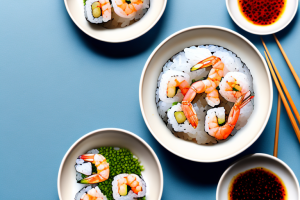How to make sushi rice with tempura vegetables
9 min read
A bowl of sushi rice with tempura vegetables
Sushi rice with tempura vegetables is an excellent dish that combines two delicious elements of Japanese cuisine. This dish is a delight for anyone who loves the combination of crunchy vegetable tempura and perfectly seasoned sushi rice. In this article, we will take a detailed look at how to make sushi rice with tempura vegetables, from the ingredients you’ll need to step-by-step instructions for achieving the perfect consistency and crunchiness.
The ingredients you’ll need to make sushi rice with tempura vegetables
The key component of sushi rice is the rice itself. You’ll need to use short-grain white rice, which is also known as sushi rice. You will also need rice vinegar, sugar, and salt to taste. For the tempura, you’ll need all-purpose flour, cornstarch, baking powder, egg, cold water, and some vegetables of your choice, such as sweet potatoes, carrots, green beans, or even shiitake mushrooms. You can also add different sauces, such as soy sauce or ponzu, for an additional burst of flavor.
When making sushi rice, it’s important to rinse the rice thoroughly before cooking to remove excess starch. This will help the rice to cook evenly and prevent it from becoming too sticky. Additionally, you can add a small amount of sake or mirin to the rice vinegar mixture for added depth of flavor.
For the tempura vegetables, it’s important to cut them into thin, even slices to ensure they cook evenly. You can also experiment with different vegetables and even proteins, such as shrimp or chicken, to create a variety of tempura dishes. To achieve a light and crispy texture, make sure the oil is hot enough before frying and avoid overcrowding the pan.
Step-by-step instructions for making sushi rice
To make sushi rice, you’ll need to wash and rinse the rice until the water runs clear. Then, you’ll need to let the rice soak in water for about 30 minutes. After that, cook the rice as you normally would but use slightly less water than usual to make it slightly firmer. Meanwhile, heat the vinegar, sugar, and salt in a small pot until the sugar dissolves. After the rice is cooked, pour the vinegar mixture onto the rice and mix thoroughly. Let the rice cool down to room temperature before using.
It’s important to note that the type of rice you use can greatly affect the outcome of your sushi rice. Short-grain Japanese rice is the most commonly used type of rice for sushi, as it has the perfect balance of stickiness and texture. However, if you can’t find Japanese rice, you can also use medium-grain or sushi rice from other countries. Just be sure to adjust the amount of water and cooking time accordingly.
Tips for achieving the perfect consistency for your sushi rice
One of the most important things in making sushi rice is to achieve the perfect consistency. You want the rice to be sticky but not too mushy. It’s crucial to use the correct amount of water during the cooking process and not overcook the rice. The soaking process is also vital to ensure the rice absorbs water and cooks evenly throughout. Additionally, after adding vinegar, salt, and sugar, it’s necessary to let the rice cool down to room temperature and not refrigerate it to prevent a firm and chewy texture.
Another important factor in achieving the perfect consistency for your sushi rice is the type of rice you use. Short-grain rice is the best option as it has a higher starch content, which makes it stickier. It’s also essential to rinse the rice thoroughly before cooking to remove excess starch and prevent clumping. Lastly, using a wooden spoon or paddle to mix the rice with the vinegar mixture will prevent the rice from becoming too sticky and clumpy.
How to make tempura batter for your vegetables
Tempura batter is a crucial element in getting the right texture for your tempura vegetables. You’ll need a mixture of all-purpose flour, cornstarch, baking powder, egg, and cold water. To make the batter, mix the flour, cornstarch, and baking powder in a bowl, and then add the egg and water. Mix the ingredients thoroughly, but don’t overmix the batter, so it stays light.
Once you’ve made your tempura batter, it’s important to use it right away. The batter will start to lose its lightness and crispiness if it sits for too long. Dip your vegetables into the batter and then fry them in hot oil until they’re golden brown. Be sure not to overcrowd the pan, as this will cause the temperature of the oil to drop and result in soggy tempura.
If you’re looking to add some extra flavor to your tempura vegetables, try adding some spices or herbs to the batter. Garlic powder, cayenne pepper, and paprika are all great options. You can also experiment with different types of flour, such as rice flour or chickpea flour, to create a unique flavor and texture. With a little bit of creativity, you can make your tempura vegetables stand out and impress your guests.
Choosing the right vegetables for your tempura
The key to making delicious tempura is choosing the right vegetables that will hold up well during the frying process. Vegetables that have a high water content, such as zucchini or cucumber, should be avoided as they may become too soggy and oil-logged. Vegetables like sweet potatoes, carrots, green beans, or shiitake mushrooms are perfect for tempura because they have a firm texture that holds up well when fried.
Another important factor to consider when choosing vegetables for tempura is their flavor. Vegetables with a mild flavor, such as sweet potatoes or green beans, work well because they don’t overpower the taste of the batter. However, if you want to add some extra flavor to your tempura, you can try using vegetables like onions, bell peppers, or even jalapenos.
It’s also important to prepare your vegetables properly before frying them. Make sure to cut them into bite-sized pieces and pat them dry with a paper towel to remove any excess moisture. This will help the batter adhere better to the vegetables and prevent them from becoming too greasy. With the right vegetables and preparation, you can make delicious tempura that will impress your friends and family.
How to properly fry your tempura vegetables
To fry your tempura vegetables, preheat your oil to 350 degrees Fahrenheit. Dip your vegetables into the tempura batter, shaking off any excess, and then gently place them into the hot oil. Fry the vegetables for approximately 2-3 minutes or until they are golden brown. Take them out of the oil with a slotted spoon, and place them on a paper towel to drain excess oil.
It is important to note that the temperature of the oil is crucial in achieving the perfect tempura vegetables. If the oil is too hot, the vegetables will burn and become bitter. If the oil is not hot enough, the vegetables will absorb too much oil and become greasy. Therefore, it is recommended to use a thermometer to ensure the oil is at the correct temperature.
Another tip for achieving crispy and delicious tempura vegetables is to use ice-cold water when making the tempura batter. The cold water helps to create a light and airy batter that will result in a crispy texture. It is also important to not overmix the batter, as this can result in a dense and heavy coating on the vegetables.
Combining sushi rice and tempura vegetables to create a delicious roll
Now that you have both the sushi rice and tempura vegetables, you can combine them to make the perfect sushi roll. Start by spreading a thin layer of rice on top of a sheet of nori. Add your tempura vegetables and roll your sushi using a sushi mat. Slice the sushi rolls into bite-sized pieces and serve with your favorite dipping sauce.
For an added twist, try adding some avocado or cucumber to your sushi roll. These ingredients will add a refreshing crunch to your roll and complement the flavors of the tempura vegetables. You can also experiment with different dipping sauces, such as soy sauce, wasabi, or spicy mayo, to find the perfect combination for your taste buds. Don’t be afraid to get creative and make your own unique sushi roll recipe!
Different types of sauces that pair well with sushi rice and tempura vegetables
There are many delicious sauces that pair perfectly with sushi rice and tempura vegetables. Soy sauce, Ponzu sauce, and even spicy mayo are all popular options. You can also make your own dipping sauce by mixing soy sauce with ingredients like rice vinegar, mirin, and sugar to your liking.
Another great sauce to try with sushi rice and tempura vegetables is teriyaki sauce. This sweet and savory sauce is made with soy sauce, sugar, and mirin, and can be thickened with cornstarch. It’s perfect for dipping tempura vegetables or drizzling over sushi rolls. Additionally, if you’re looking for a healthier option, you can try a ginger dressing made with grated ginger, rice vinegar, soy sauce, and sesame oil. This dressing adds a refreshing and tangy flavor to your sushi and tempura dishes.
Suggestions for variations on the classic sushi roll using tempura vegetables
There are endless possibilities for variations on the classic sushi roll using tempura vegetables. Experiment with different vegetables, such as broccoli or cauliflower. You can also add protein to your sushi rolls, such as shrimp tempura or crab meat. Add some texture to your roll by using sesame seeds, crispy onions, or even crushed potato chips as a topping.
Preparing a dipping sauce to compliment your sushi roll
There are many different sauces you can make to accompany your sushi roll. Soy sauce and wasabi are always a good choice, but you can also mix soy sauce with rice vinegar, mirin, and sugar to make your own dipping sauce. You can even make a spicy mayo by mixing mayonnaise with sriracha sauce or chili flakes.
Tips and tricks for plating and presentation of your dish
When it comes to plating, simplicity is key. Arrange your sushi roll on a simple white plate, and add some color by using a few slices of avocado or a sprinkle of sesame seeds. If you’re feeling more adventurous, you can add some garnishes like seaweed salad or pickled ginger.
How to store leftover sushi rice and tempura veggies
If you have leftover sushi rice and tempura vegetables, store them separately in airtight containers in the refrigerator. The rice will last for up to three days, while the tempura vegetables are best eaten the same day. Do not freeze the sushi rice or the tempura vegetables, as this may alter their texture and taste.
Frequently asked questions about making sushi rice with tempura vegetables
Q: Can I use brown rice instead of sushi rice?
A: Unfortunately, brown rice won’t work for sushi rice because it has a different texture and taste. Sushi rice requires short-grain white rice to achieve the perfect stickiness.
Q: What’s the best oil to use for frying tempura vegetables?
A: The best oil to use for frying tempura vegetables is vegetable oil or canola oil. Both have a high smoke point and a neutral flavor that won’t overwhelm the taste of the vegetables.
Q: Can I refrigerate leftover sushi rice?
A: You can refrigerate leftover sushi rice, but it’s important not to put it in the freezer. Freezing sushi rice will alter its texture and make it difficult to work with in future dishes.
Q: Can I make tempura without egg?
A: Yes, you can make tempura without egg using a mixture of flour, cornstarch, and water. The egg is not a required ingredient, but it does add some richness and fluffiness to the batter.
With the instructions in this article, you’ll be able to make sushi rice with tempura vegetables like a pro. Combining the perfect sushi rice with crispy tempura vegetables is a match made in heaven that will leave everyone craving for more. Enjoy!


